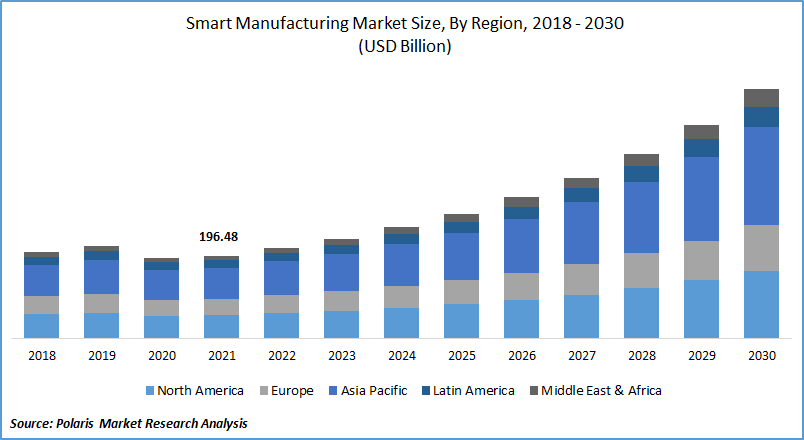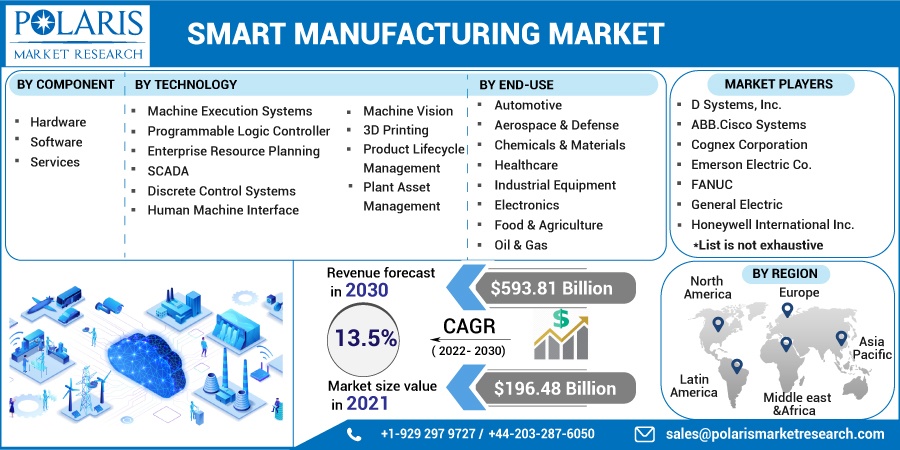
Smart Manufacturing Market Share, Size, Trends, Industry Analysis Report, By Component (Hardware, Software, Services); By Technology; By End-Use; By Region; Segment Forecast, 2022 - 2030
- Published Date:Jun-2022
- Pages: 114
- Format: PDF
- Report ID: PM2005
- Base Year: 2021
- Historical Data: 2018 - 2020
Report Outlook
The global smart manufacturing market was valued at USD 196.48 billion in 2021 and is expected to grow at a CAGR of 13.5% during the forecast period. The rising market demand for smart manufacturing due to industry 4.0 is propelling the global market growth. In addition, the development of cloud computing technology for paving its path across numerous sectors such as manufacturing, automotive, healthcare, and others may be attributed to the smart manufacturing market demand.
 Know more about this report: Request for sample pages
Know more about this report: Request for sample pages
Furthermore, growing expenditures on research and development activities and rising investment in technical improvements by the market's leading competitors are major variables that will catalyze the smart manufacturing market's growth in the coming years. The world is fighting against the COVID-19 pandemic and trying to prevent the spread of the deadly coronavirus. Consequently, several governments regulate mandatory lockdown in various areas, which develops a decisive gap among supply chain and production units and reduces the smart factories' shipment of solutions and components.
To overcome this impact, enterprises are reforming their business models, discovering automation prospects, and investing in installing up-grade supply chain and manufacturing models. Therefore, the smart manufacturing market demand is projected to grow due to rising energy, resource, and intelligent automation efficiency. Consequently, long-term market growth is influenced by the rearrangement of the manufacturing market and strategic developments by the leading players, which, in turn, fuels the market growth of intelligent manufacturing in the coming years.
 Know more about this report: Request for sample pages
Know more about this report: Request for sample pages
Industry Dynamics
Growth Drivers
The increasing number of technological advancements in wireless sensor networks and their penetration across smart factories is a major driving factor that accelerates the market growth of smart manufacturing over the forecast period. Integration of wireless networks with dispersed autonomous devices comprises sensors for analyzing environmental and physical circumstances and is often recognized as a wireless sensor network (WSN). This sensor is usually adopted in the sectors such as water & wastewater treatment, oil & gas, and pharmaceutical.
In an oil & gas vertical plants, generators, tanks, separators, and compressors are managed, checked, and controlled with the help of sensors deployed in a WSN. The adoption of the WSN decreases the spending linked with the deployment of a communication system and sensor network. Growing usage of WSN in a supervisory control and data acquisition (SCADA) system and other smart factory solutions and components facilitates real-time data monitoring and process control.
Therefore, increasing research and development activities for WSN and vigorous implementation in the smart factories boost the growth of application areas in smart factories. Thus, these factors may contribute to the growth of smart manufacturing in the forecasting period owing to the constant updates in wireless sensor networks.
Report Segmentation
The market is primarily segmented based on component, technology, end-use and region.
|
By Component |
By Technology |
By End-Use |
By Region |
|
|
|
|
Know more about this report: Request for sample pages
Insight by Technology
The Distributed Control System (DCS) segment is the leading segment in revenue generation in 2021 and is expected to dominate the market in the upcoming years. Owing to the features such as it is flexible, scalable, visualization, and easy to use in processes like monitoring, controlling, and reporting as well as it aids in improving system availability and reliability.
DCS is proficient in managing core operations, safety roles, and maintenance across different plant applications and procedures. Furthermore, the launch of DC systems across various industries easily installs without compromising performance and process safety, leading to the dominance of the segment around the world. The 3D printing segment is estimated to show substantial growth in the forecast period because it helps produce sophisticated components with convenient physical and competent attributes in every stage. In addition, it also provides pace, potency, and quality in the overall process of production and supplies a wide variety of applications and industries.
Insight by End-Use
The automotive segment was the largest revenue generator holding the highest shares in the global market in 2021. Smart factory solutions facilitate numerous benefits such as sustainability, premium quality, raises asset competence, and reduces operational cost are the prominent factors that boost the segment growth, which in turn will increase the market of smart manufacturing further.
Moreover, the increasing penetrations of industrial robots and growing investments in the smart factory are likely to provide several benefits such as product quality, stable employees, productivity, and rising product supplies in the market. Therefore, automation of the production plants creates a lucrative segment growth worldwide, boosting the market demand for the smart manufacturing industry.
The aerospace and defense industry segment is expected to show the highest CAGR in the near future due to increasing investment in smart manufacturing solutions, rising optimization & visibility in the supply chain and product samples.
Geographic Overview
Asia Pacific is the largest revenue contributor in 2021 and is expected to dominate the global market in the forecasting period. Growing focus on automating in-house manufacturing services and lessening reliance on other regions are the chief driving factor for the regional growth. In addition, deploying smart manufacturing solutions leads to growing manufacturers' focus on reforming their supply chains to enhance workplace safety and decrease operational costs in the manufacturing process.
Countries like Japan are the leading manufacturing centers for creating factory automation solutions and delivering them to other nations across the region, leading to the availability of the solutions at a reasonable price for developing countries India and China. Therefore, these factors create a productive smart manufacturing market demand for smart manufacturing in the Asia Pacific. Moreover, the Middle East and Africa are projected to grow at the highest CAGR globally in the upcoming years.
The factors such as the rising number of government initiatives for technological advancement and increasing spending by the leading players for smart manufacturing development create a curative market demand for smart manufacturing in the coming years. For instance, in April 2020, Infor will support manufacturers across the Middle East, Turkey, and Africa in embracing digital transformation and enforcing the development of the 4.0 industrial revolution. Accordingly, these factors foster market growth across the Middle East and Africa.
Competitive Insight
Some of the major players operating in the global smart manufacturing market include 3D Systems, Inc., ABB., Cisco Systems, Cognex Corporation, Emerson Electric Co., FANUC, General Electric, Honeywell International Inc., Mitsubishi Electric Corporation, Robert Bosch GmbH, Rockwell Automation, Inc., SAP, Schneider Electric, Siemens, Stratasys Ltd., and Yokogawa Electric Corporation.
Recent Developments
- July 2024: 3D Systems Inc. (US) and Precision Resources (US) formed a strategic alliance in order to expand and speed up additive manufacturing. According to 3D Systems, the extensive application knowledge of both organizations with 3D System’s Direct Metal Printing (DMP) platform is going to enable a faster route to market for applications in high-criticality sectors.
- June 2024: ABB (Switzerland) unveiled OmniCore, an advanced automation platform developed to be faster, more accurate, and more sustainable. With its unique, single-control architecture, the platform integrates ABB’s complete range of hardware and software.
Smart Manufacturing Market Report Scope
|
Report Attributes |
Details |
|
Market size value in 2021 |
USD 196.48 Billion |
|
Revenue forecast in 2030 |
USD 593.81 Billion |
|
CAGR |
13.5% from 2022 - 2030 |
|
Base year |
2021 |
|
Historical data |
2018 - 2020 |
|
Forecast period |
2022 - 2030 |
|
Quantitative units |
Revenue in USD billion and CAGR from 2022 to 2030 |
|
Segments covered |
By Component, By Technology, By End-Use, By Region |
|
Regional scope |
North America, Europe, Asia Pacific, Latin America; Middle East & Africa |
|
Key Companies |
D Systems, Inc., ABB.Cisco Systems, Cognex Corporation, Emerson Electric Co., FANUC, General Electric, Honeywell International Inc., Mitsubishi Electric Corporation, Robert Bosch GmbH, Rockwell Automation, Inc., SAP, Schneider Electric, Siemens, Stratasys Ltd., and Yokogawa Electric Corporation |
